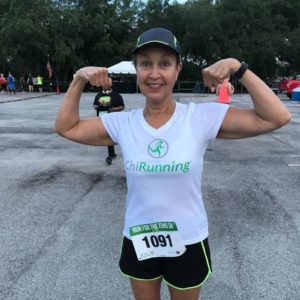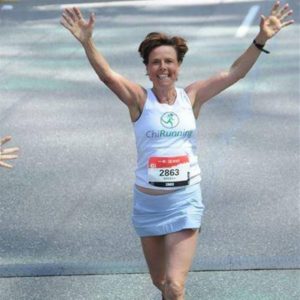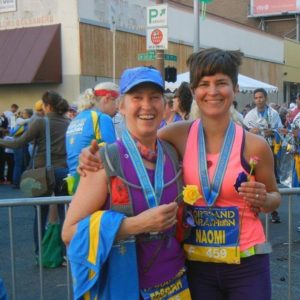ChiLiving > Knowledge Center > Frequently Asked Questions
Curious about ChiRunning or ChiWalking? You’ve come to the right place! Our team has created this FAQ page to answer our most commonly asked questions about ChiRunning and ChiWalking. If you don’t see your question in the list, feel free to share your question with us using the form below.
Chi (pronounced chee as in cheetah) is the Chinese term for “that which animates all life.” It is also called “life force energy.” The ChiRunning and ChiWalking techniques have blended movement principles from the ancient martial art, T’ai Chi, with the active sports of running and walking. This blend creates a more mindful, centered and balanced approach to fitness.
Yes, there is crossover into other sports, certainly for running and likely for other sports/activities. ChiRunning is all about moving from your center and using your the strength of your core. Just as Pilates and Yoga teach, powerful movement comes from your center. Movement that comes from the core, your center, is more balanced, has greater strength behind it, and provides greater stability while allowing your peripheral muscles to relax. Anytime you can pair strength and relaxation, you’ll become a better athlete.
With the ChiRunning technique, you are working towards effortless running. As your form improves, you’ll be able to run with less and less effort, but still get a great workout. The movement of ChiRunning keeps your peripheral muscles supple and relaxed and your core muscles strong while improving your cardiovascular and aerobic conditioning. You’ll still reap all the physical benefits of running, but do it in a more mindful, efficient way to improve enjoyment and prevent injury.
Yes! ChiRunning helps to eliminate knee problems by eliminating the reason for why they come up in the first place. By teaching you how to prevent over-striding, heel-striking and dorsiflexing, ChiRunning puts the issue to rest permanently. Read more about preventing knee injury on our blog.
The foundation of ChiRunning is good posture and proper biomechanics, both of which will help many back problems. You should always check with a health practitioner before starting an exercise program but you’ll be glad to know that many people who have stopped running due to back problems have found that ChiRunning actually helps their back. This technique strengthens your abdominals, which will relieve contracted lower back muscles.
It depends on your conditioning. For someone just starting an exercise program, it is best to start with ChiWalking, making sure to create a safe and solid foundation to your exercise program. If you are exercising regularly you can use the ChiRunning technique to as an excellent form of exercise. We highly recommend pairing your exercise program with proper nutrition and lifestyle choices to lose weight and get healthy in a sustainable manner.
Yes! Shin splints are generally caused by overuse or inappropriate use of the tibialis anterior muscle. This technique keeps you off your heels and toes, preventing irritation of this muscle. Please read about Shin Splints on our Injury Prevention and Recovery page for a detailed explanation.
We do not suggest that beginning runners run a marathon in the first year of running. True beginners should train for a half marathon over a minimum of 6 months and longer if possible. The key is to make sure you take the time to learn proper running technique without forcing or powering your way to a certain distance goal. You can train for any distance after you’re comfortable with the ChiRunning technique.
Contact one of our many Certified Instructors! We have a growing team of over 200 Certified Instructors around the world who would be happy to work with you to bring ChiRunning or ChiWalking to your community.
It depends. If you really can't walk or move at the time of the workshop, it wouldn't be as worthwhile. Feedback from the Certified Instructor during the workshop could be limited. You might get the same information as others, but may not have the same experience, because our goal is for attendees get a Body Sense of the technique during the workshop, which can be difficult if you can barely walk. If you are reasonably mobile by the time of the workshop, you'll get a lot out of it, and learn how to avoid the same injuries in the future. All to say ... it's up to you. You can also reach out to the specific Certified Instructor with any questions or concerns prior to registration.
We have many customers in the 65+ age range. Many have had some running experience, but there are beginning runners who come to us at age 60 desiring a new approach to fitness. One of Danny’s clients, Helen Klein, is over 80 years old and continues to run marathons. She ran a 4:31 marathon and also participants in ultra-marathons. If you want to run, ChiRunning gives you the tools to make it safe and enjoyable.
Absolutely! The book has all the information you need to learn the basic form techniques. Be patient with yourself. There have been some people who have been able to find more ease and joy in their running from integrating only one or two focuses from the book. Using the DVD and/or CD will give you additional visual and audio cues that can make the learning process easier. We highly recommend teaming up with a partner to learn the ChiRunning technique. You can also attend a workshop and find a Certified Instructor.
Most other running methods depend on strong leg muscles, so their emphasis is on leg conditioning and strengthening. ChiRunning emphasizes using core muscles which are stronger and more efficient. You’ll learn how to engage gravity, letting it do the work instead of your legs.
Beginning runners consistently make up a large percentage of our workshop attendees. Don't hesitate to attend a workshop. If the workshop is geared for more advanced runners, the description will say so. Contrary to what you might think, most workshops don’t include a lot of running. Instead, we focus on exercises and drills to teach you the form. Many of our favorite success stories come from customers just getting started with running.
Yes, you can practice ChiRunning on a treadmill, but it’s very different from running outdoors. You can read an extensive explanation about treadmill running in Chapter 7 of ChiRunning(2009). Reducing impact and injury is more difficult on a treadmill than it is on road, track or trail running, but you can still put the technique to use.
Triathletes love ChiRunning because when they get off their bike their legs can take a rest! With this technique, you can rest and relax your legs while gravity does the work of pulling you forward.
ChiWalking and ChiRunning have lots of similarities and several significant differences in the technique.
The biggest differences in terms of technique are: footfall, stride length and cadence.
ChiWalking is a great place to begin learning the Chi Principles and start a regular practice of intentional movement or supplement your current running practice.
ChiRunning is beneficial for runners who want to experience less discomfort or pain while running, and more ease and joy from their practice.
Most definitely. ChiRunning gives beginners the confidence to run correctly from the start. Since you'll be learning correct biomechanics, your running will be easier for you because you'll be a more efficient runner. You do not need any previous running experience to learn ChiRunning and enjoy all its benefits.
No, you do not. Both ChiWalking and ChiRunning blend movement the principles from T'ai Chi with the sports of walking and running, and do not require any knowledge of T'ai Chi. Danny did the hard work for you and our resources and Certified Instructors will teach you everything you need to know!
All products have a 30-day, money-back guarantee. In other words, if you aren't happy for any reason within 30 days, just let us know and we'll refund your money, no questions asked.
Chi (pronounced chee as in cheetah) is the Chinese term for “that which animates all life.” It is also called “life force energy.” The ChiRunning and ChiWalking techniques have blended movement principles from the ancient martial art, T’ai Chi, with the active sports of running and walking. This blend creates a more mindful, centered and balanced approach to fitness.
Very young children have naturally relaxed, and typically excellent, walking form. However, as we age, we lose the relaxed movement of early childhood because we spend an extraordinary amount of time in sedentary positions, sitting, driving, at the computer or in front of the TV. All of these changes affect our walking, and our walking affects our body movement.
Learning good walking form with ChiWalking can prevent a myriad of problems, including back pain, knee pain, hip pain, etc. Walking also helps prevent arthritis.
ChiWalking uses elements of T'ai Chi which has been shown to improve balance, strength and improve cognition. By learning good form you can walk more efficiently and with less wear and tear on the body as you age.
Most people walk by primarily using the muscles in their legs. As a result, people lead with their legs and pull themselves forward. ChiWalking teaches you to use your core muscles rather than your leg muscles, allowing your upper body to lead your lower body. This forward movement engages the pull the gravity, which then becomes your ally. In ChiWalking, your arms are engaged, and good posture and body alignment help you become a more efficient, balanced walker.
Most types of power walking require a great deal of leg strength and toe-off. ChiWalking requires lower leg relaxation while letting your upper body lead, rather than pushing off with your toes and feet. When you push with your feet you're more apt to get shin splints and other lower leg injuries and problems.
Race walking is a very specific form of walking, and different from ChiWalking. The biggest difference is that in race walking, the front leg is required to be straight when making contact with the ground. In ChiWalking, we teach you how to use knee bend to keep your stride short and concise beneath your body, to minimize the impact from the force of the oncoming road. You can read more about the differences in the ChiWalking book.
For some types of injury and pain, ChiWalking may be just what you need. For others, it may not be appropriate until you are more fully recovered. You should always check with your health care practitioner before engaging in any fitness program, especially if you are injured, in pain, or recovering from illness. We encourage you to listen carefully to your own body by Body Sensing any time you walk and stop immediately if it is ever painful. ChiWalking relies on the movement principles from T'ai Chi, which have been shown to improve balance, strength and improve cognition. With good form you can walk more efficiently and fluidly, with less wear and tear on your body.
Most definitely, you can learn ChiWalking from the book. Some customers have had breakthroughs after reading only one chapter. However, the DVD can really help you visualize exactly what the technique looks like. We've done our best with photos in the book, but there is nothing like a moving picture to explain movement. It also depends on you. Go through each lesson in the book slowly and carefully. If you need more help, the DVD, audio CD or a Certified Instructor are great educational resources.
A consistent fitness and diet program will help you lose and maintain a healthy weight. We believe proper eating habits should regulate your weight, while your exercise habits regulate your general health and sense of well being. Our goal with ChiWalking is to make your walking program a regular, ongoing part of your life. There is always more to learn about how your body moves and works, and walking is an excellent way to keep learning. As you get better at Body Sensing and listening to your body, you will also become more adept at listening to the messages about food that your body is telling you.
The ChiWalking book and DVD package is the best place to start. You can learn a lot form these home study materials. We also suggest learning with a friend. Many Certified Instructors are willing to travel to conduct a workshop, especially if they have an enthusiastic supporter like you to help arrange it.
ChiWalking and ChiRunning have lots of similarities and several significant differences in the technique.
The biggest differences in terms of technique are: footfall, stride length and cadence.
ChiWalking is a great place to begin learning the Chi Principles and start a regular practice of intentional movement.
ChiWalking is also beneficial for runners returning from injury or runners training for ultra events and want to integrate recovery walks into your practice.
No, you do not. Both ChiWalking and ChiRunning blend movement the principles from T'ai Chi with the sports of walking and running, and do not require any knowledge of T'ai Chi. Danny did the hard work for you and our resources and Certified Instructors will teach you everything you need to know!
Most definitely. ChiWalking is a great place to start because it gives beginners the opportunity to use their body the way it's designed to move. ChiWalking is a good partner to have if you are on a journey to good health or would like to become a runner in the future.












Share Your ChiWalking, ChiRunning, and living your best ChiLife photos with us!
© 2025 chiliving inc All rights reserved | privacy policy
website design & development by inkriot marketing & mad cow web design